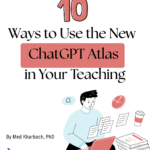– Siddharth Rajgarhia, Chief Learner and Director, Delhi Public School (Varanasi, Nashik, Lava Nagpur, Hinjawadi Pune) & Co-Founder, Equanimity Learning
Indian education has long been celebrated for its rigour, its structure and its ability to create disciplined learners. However, it has also faced criticism for too much emphasis on rote memorisation and examination driven success. While I firmly believe that structure is necessary for education, the significance of “memorisers” has an important question to be answered: are we limiting creativity and innovation in our classrooms? This moment encapsulates the larger question – is Indian education measuring our learning in a way that eventually limits it?
The Weight of the Curriculum
The Indian syllabus, CBSE, ICSE, state boards are often described as exhaustive not explorative. Students feel that they must complete large, seemly endless, syllabus within a short time, and our teaching becomes limited simply to “finishing the portion.” This results in a norm where textbooks are revered like sacred texts and curiosity driven learning is pushed away like a distraction.
The Cost of Rote Learning
An ASER Report, 2023 (www.asercentre.org), notes that while over 73 percent of Class V students can read basic texts, less than 50 percent can solve even simple division, suggesting a disconnect between rote learning and applied learning. Similarly, a UNESCO report in 2022 revealed that Indian students use almost 80 percent of classroom time to prepare for exams, a process which does not allow schools to engage students in creativity or skill enhancement.
Blocked Creativity: if students are scared of moving away from “model answers” they learn conformity, not questioning
Stress multiplied: The exam-focused model has also contributed to damaging, unhealthy levels of pupil stress and anxiety, which has exasperated cases of suicide
Innovation lost: India has some of the best engineers and doctors in the world. However, employers have identified that many graduates are lacking in flexibility, originality, and the ability to engage with what is learnt
The Global Contrast
We should trust and listen to the students. Listening to them gives me a direct window into their thought processes, their aspirations, and their boundless creativity. Each conversation reinforces a simple truth: every child has high potential; we only need to provide the right scenario for it to flourish.
Countries like Finland, Singapore, and even South Korea (once notorious for rote learning) have restructured their systems to prioritise skills over scores. Project-based assessments, open-ended inquiry, and interdisciplinary learning have become hallmarks of global best practices. In contrast, India continues to treat the exam paper as the ultimate verdict on a child’s intelligence.
Rays of Change in India
Fortunately, the National Education Policy (NEP) 2020 indicates a new direction. With its focus on competency-based learning, minimal curriculum-load, and holistic report cards, the policy strives to reposition assessment back in to the realm of creativity. Other progressive schools are also starting down a path with experiential pedagogy, design thinking projects, and relaxed parameters for assessment.
Creativity in education is not purely artistic; it is also a sense of curiosity, willingness to experiment, and an indication towards a shift in curtailing an unreasonably established order. By 2030, research from the World Economic Forum (2023) indicates that creativity, analytical thinking and problem-solving will be the top three skills that the future workforce will require.
Educators must begin by selecting the life skill and the key concepts that students will be expected to master as a culminating experience. Educators shall then design lessons that scaffold students’ understanding of the content while also allowing students the opportunity to prepare for an authentic performance task, – a project or scenario where students need to draw upon their personal learning in a new situation – that demands critical and creative thinking.
Towards a Balanced Future
The discussion can move away from a curriculum versus creativity argument to one that deals with curriculum with creativity. Yes, India needs some kind of framework that allows for equity in education, but beyond that framework, education must allow for curiosity, reflection, and imagination. With this is mind, some potential next steps are:
1. Change the Exams: Stop asking questions that test students’ memory and devise more application, analysis and scenario-based exams
2. Empower Teachers: Provide professional development in inquiry-based practice so that teachers can balance the curriculum and creativity
3. Use Portfolios: Institute systems where students’ portfolios—projects, essays, art work, social action etc—are taken into account like exams
4. Plan Backwards with Performance Tasks: Embrace backward planning that allows the curriculum to be designed with the end in mind, and assessments that require students to use concepts to solve real-world problems instead of just memorizing notes.
5. Shift Parent Mindset: Educate parents on understanding that marks are not the only reward
The irony is that India, which had a vast civilisational experience and philosophical depth from the Upanishads to the birth of zero, now restricts students to rote learning in classrooms. To encourage innovators, entrepreneurs, and problem solvers to face an uncertain future, we must rethink how we assess and define learning. Examinations assess memory, but life is about imagination.
Also read: India’s education reset: nurturing thinkers over test-takers







